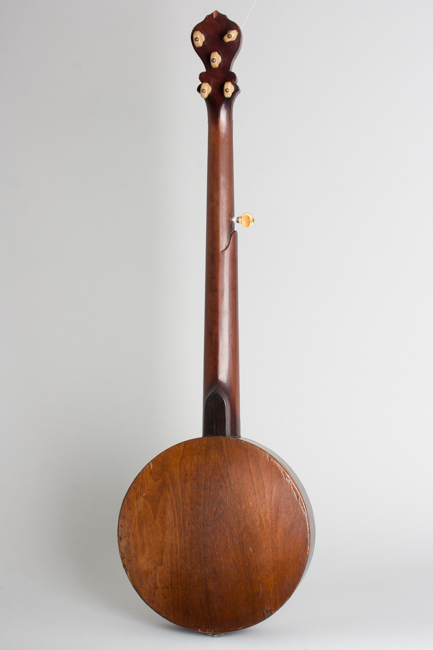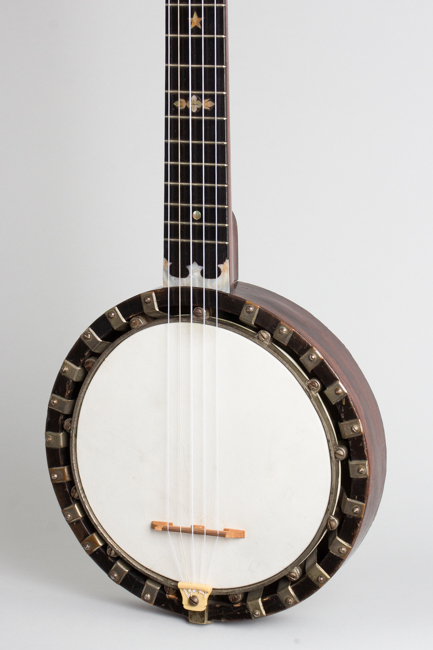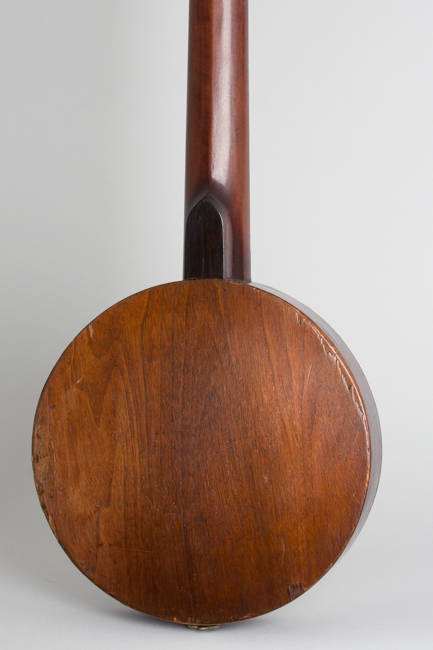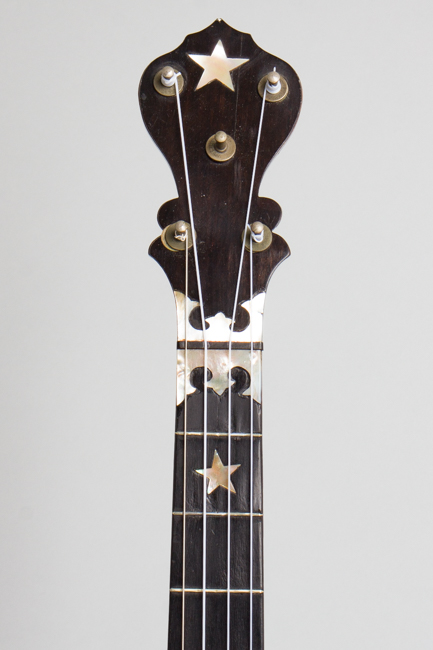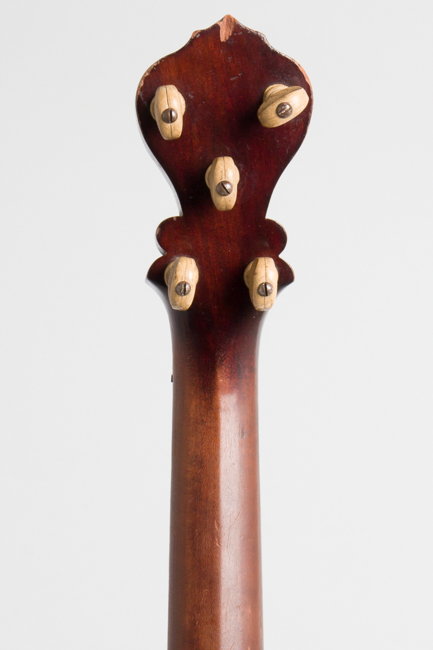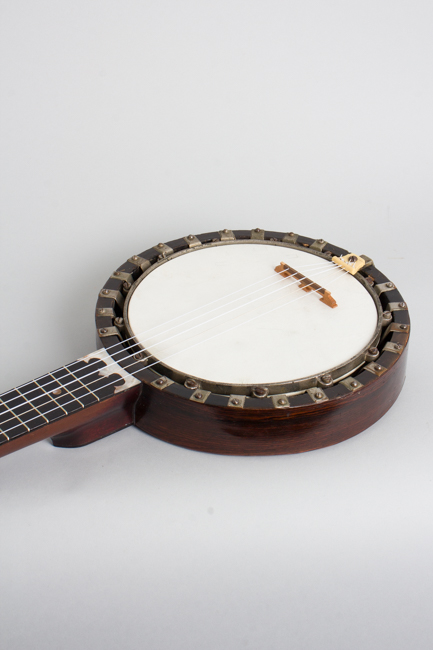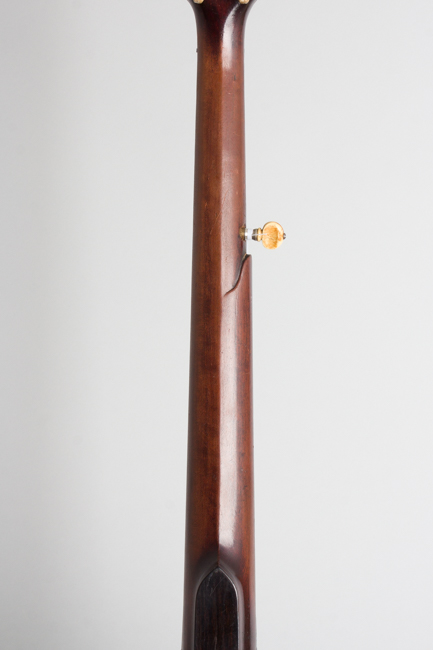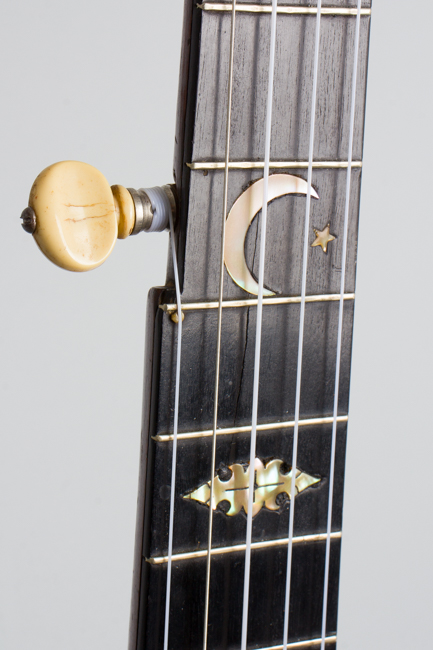Alfred Cammeyer 6 String Banjo , c. 1885
Alfred Cammeyer 6 String Banjo, c. 1885, made in Brooklyn, NY, dark brown varnish finish, laminated mahogany resonator, cast metal rim, mahogany neck with ebony fingerboard, black gig bag case.
This is one of the most interesting "local history" pieces to come to our door; an original 1880s banjo by Alfred D. Cammeyer made (or at least assembled) right here in Brooklyn, NY. It is full of interesting and unusual features that never caught on in the US, but became the basis for the English zither-banjo which was widely popular "over the pond" well into the next century. New York made Cammeyer banjos are extremely rare and this is the first such instrument we have ever seen.
Brooklynite Alfred D. Cammeyer was born in 1862; as a young man became a concert banjoist, switching over from violin at age 14. While still a teen Cammeyer was already tinkering with ideas to improve the banjo; He seems to have gotten many ideas fellow New Yorker George Teed. Teed's 1860s instruments were extremely advanced for the day, using a top-tension head and wooden resonator construction that were "re-discovered" and lauded as new ideas in the 1920s!
Following a suggestion from British opera diva Adelina Patti, Cammeyer traveled to London in 1888. Soon enough he was performing for London's high society. Sir Arthur Sullivan (of Gilbert & Sullivan) encouraged him to compose solos for the now-renamed zither-banjo, which soon became very popular. In 1893 Cammeyer partnered with Clifford Essex to produce zither-banjos under the "Essex & Cammeyer" brand, setting up a London manufacturing facility. The partnership dissolved in 1900 but A.D. continued to make mostly zither-banjos until retiring in 1939. Many other English builders made instruments to the same design, notably Windsor, and they are still played in England today.
This older New York-made banjo pre-dates this overseas success; it is not branded, but unmistakably Cammeyer's design. It has a separate top-tension metal rim suspended inside a wood resonator body, the hallmark of his instruments and the prototype for generations of English and European banjos to come. The wood working and inlay pattern are very similar to instruments sold in NY labeled for James Morrison; these all may be product of the city's prolific Buckbee factory. One anomaly is it was designed for six strings, five for play and a dingle drone. It is currently set up in standard five string format, but could be restored to six if desired.
The "floating" head is only 8 1/2" in diameter, far smaller than most 1880s banjos giving a correspondingly brighter tone. The neck has a 25" scale, somewhat shorter than most from the period. The fingerboard is inlaid with shaped pearl, somewhat sloppily by contemporary 1880's standards but typical of many period New York instruments. The five tuners on the headstock are period friction units with composite buttons; they may not be original to the instrument but it is hard to tell for sure. The tailpiece is period but not original; it is cut for five strings. The rim hardware appears original, indeed unique to this instrument with screws to tension the head and half the rim mounting brackets being for decoration only.
This is a fully playable instrument strung with NylGut strings and has a distinctive and very pleasing sound. As with most 19th century banjos we find it sounds fuller tuned a bit under modern G tuning, which is more authentic to the period. Alfred Cammeyer lived until 1949, having seen his banjo design become the toast of England while being forgotten at home. We like to think he would be pleased to see one of his early creations played in his hometown nearly 150 years on!
Overall length is 35 1/2 in. (90.2 cm.), 8 1/2 in. (21.6 cm.) diameter head, and 2 in. (5.1 cm.) in depth, measured at side of rim. Scale length is 25 in. (635 mm.). Width of nut is 1 1/2 in. (38 mm.).
This is a fully playable if very well-worn instrument; it is after all creeping up on a century and a half old! There is a lot of wear to the finish overall including dings, scrapes and a number of small chips to the veneer. The back of the resonator is heavily worn away on the top edge and there are a few pieces of veneer missing in a couple of spots; the top of the rim has numerous old chips and scratches. There is a very old and somewhat sloppy repair to the back/side seam on the rim of the treble side. The neck is in surprisingly good shape; it is still quite straight and has wear to the frets and fingerboard but still plays fine. The frets appear original; the ebony nut is later, cut for four play strings.
All the rim hardware is original except the tailpiece, which is period. There is predictably a decent amount of plating loss and corrosion to the metalwork, but everything works as intended. The tuners are also period, with no comparable instruments available to review we cannot say if these were an original fitting or not. The bridge is later. The banjo is set up as a typical 19th century 5-string with a skin head an NylGut strings and plays and sounds quite nice; although English zither banjos are generally partially steel strung we would recommend gut or nylon stringing on this instrument both for sonic and long-term care reasons. This is a truly historic banjo, an important if obscure piece of both New York and English banjo history and a surprisingly fun instrument to play! Overall Very Good + Condition.
This is one of the most interesting "local history" pieces to come to our door; an original 1880s banjo by Alfred D. Cammeyer made (or at least assembled) right here in Brooklyn, NY. It is full of interesting and unusual features that never caught on in the US, but became the basis for the English zither-banjo which was widely popular "over the pond" well into the next century. New York made Cammeyer banjos are extremely rare and this is the first such instrument we have ever seen.
Brooklynite Alfred D. Cammeyer was born in 1862; as a young man became a concert banjoist, switching over from violin at age 14. While still a teen Cammeyer was already tinkering with ideas to improve the banjo; He seems to have gotten many ideas fellow New Yorker George Teed. Teed's 1860s instruments were extremely advanced for the day, using a top-tension head and wooden resonator construction that were "re-discovered" and lauded as new ideas in the 1920s!
Following a suggestion from British opera diva Adelina Patti, Cammeyer traveled to London in 1888. Soon enough he was performing for London's high society. Sir Arthur Sullivan (of Gilbert & Sullivan) encouraged him to compose solos for the now-renamed zither-banjo, which soon became very popular. In 1893 Cammeyer partnered with Clifford Essex to produce zither-banjos under the "Essex & Cammeyer" brand, setting up a London manufacturing facility. The partnership dissolved in 1900 but A.D. continued to make mostly zither-banjos until retiring in 1939. Many other English builders made instruments to the same design, notably Windsor, and they are still played in England today.
This older New York-made banjo pre-dates this overseas success; it is not branded, but unmistakably Cammeyer's design. It has a separate top-tension metal rim suspended inside a wood resonator body, the hallmark of his instruments and the prototype for generations of English and European banjos to come. The wood working and inlay pattern are very similar to instruments sold in NY labeled for James Morrison; these all may be product of the city's prolific Buckbee factory. One anomaly is it was designed for six strings, five for play and a dingle drone. It is currently set up in standard five string format, but could be restored to six if desired.
The "floating" head is only 8 1/2" in diameter, far smaller than most 1880s banjos giving a correspondingly brighter tone. The neck has a 25" scale, somewhat shorter than most from the period. The fingerboard is inlaid with shaped pearl, somewhat sloppily by contemporary 1880's standards but typical of many period New York instruments. The five tuners on the headstock are period friction units with composite buttons; they may not be original to the instrument but it is hard to tell for sure. The tailpiece is period but not original; it is cut for five strings. The rim hardware appears original, indeed unique to this instrument with screws to tension the head and half the rim mounting brackets being for decoration only.
This is a fully playable instrument strung with NylGut strings and has a distinctive and very pleasing sound. As with most 19th century banjos we find it sounds fuller tuned a bit under modern G tuning, which is more authentic to the period. Alfred Cammeyer lived until 1949, having seen his banjo design become the toast of England while being forgotten at home. We like to think he would be pleased to see one of his early creations played in his hometown nearly 150 years on!
Overall length is 35 1/2 in. (90.2 cm.), 8 1/2 in. (21.6 cm.) diameter head, and 2 in. (5.1 cm.) in depth, measured at side of rim. Scale length is 25 in. (635 mm.). Width of nut is 1 1/2 in. (38 mm.).
This is a fully playable if very well-worn instrument; it is after all creeping up on a century and a half old! There is a lot of wear to the finish overall including dings, scrapes and a number of small chips to the veneer. The back of the resonator is heavily worn away on the top edge and there are a few pieces of veneer missing in a couple of spots; the top of the rim has numerous old chips and scratches. There is a very old and somewhat sloppy repair to the back/side seam on the rim of the treble side. The neck is in surprisingly good shape; it is still quite straight and has wear to the frets and fingerboard but still plays fine. The frets appear original; the ebony nut is later, cut for four play strings.
All the rim hardware is original except the tailpiece, which is period. There is predictably a decent amount of plating loss and corrosion to the metalwork, but everything works as intended. The tuners are also period, with no comparable instruments available to review we cannot say if these were an original fitting or not. The bridge is later. The banjo is set up as a typical 19th century 5-string with a skin head an NylGut strings and plays and sounds quite nice; although English zither banjos are generally partially steel strung we would recommend gut or nylon stringing on this instrument both for sonic and long-term care reasons. This is a truly historic banjo, an important if obscure piece of both New York and English banjo history and a surprisingly fun instrument to play! Overall Very Good + Condition.


